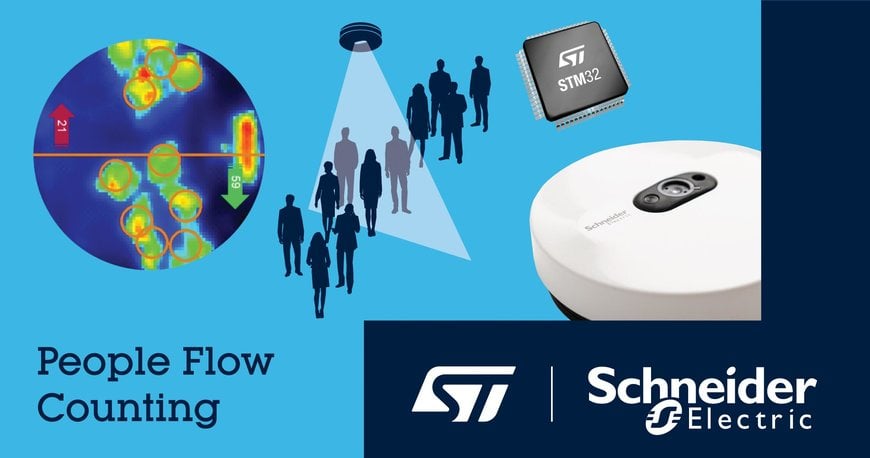www.industryemea.com
27
'20
Written on Modified on
STMICROELECTRONICS AND SCHNEIDER ELECTRIC REVEAL ADVANCED PEOPLE-COUNTING SOLUTION USING ARTIFICIAL INTELLIGENCE ON STM32 MICROCONTROLLER
Artificial Intelligence at the very edge enables digital attendance monitoring for smart buildings.

STMicroelectronics (NYSE: STM), a global semiconductor leader serving customers across the spectrum of electronics applications , and Schneider Electric, the leader in the digital transformation of energy management and automation, are demonstrating a prototype IoT sensor that enables new building-management services and efficiency gains by understanding building-occupancy levels and usage.
The two companies have collaborated to integrate Artificial Intelligence (AI) into a high-performance people-counting sensor, which overcomes the challenge of monitoring attendance in large spaces with multiple entrance points. Schneider Electric will demonstrate this IoT sensor as a guest ST Live Days, during the IoT&5G session on November 19, 2020.
With the digitization of building occupancy, Schneider is following its mission to be its customers’ digital partner for sustainability and efficiency by delivering new and highly valuable insights such as queue monitoring to assist smart building management while respecting individuals’ privacy by design. The advanced IoT sensor has been developed by combining the high expertise of ST’s AI group and the deep sensor-application expertise of Schneider Electric to identify and embed a high-performing object-detection neural network in a small microcontroller (MCU).
Schneider Electric’s increase in design productivity comes from its use of the STM32Cube.AI toolchain, which has mature capabilities for developing AI applications for the broad portfolio of STM32 MCUs. This allowed Schneider Electric to gain valuable flexibility and efficiency in hardware design from the engineering resources, sophistication, and ease of use provided by the STM32Cube software-development ecosystem.
The prototype people-counting sensor combines a LYNRED ThermEyeTM family thermal imager, integrated in a unique ultra-low-power design created by Schneider Electric, with a Yolo-based Neural Network model running on the recently introduced high-performance STM32H723 MCU from ST.
“This promising technology opens a new solution for attendance monitoring and people counting in numerous applications such as monitoring queues, building usage, and social distancing,” said Maxime Loidreau, IoT Sensors Program Manager at Schneider Electric. “Our innovative demonstration, created with STMicroelectronics, finds applications in various segments, from hotels to offices and retail, and more generally any building where knowing attendance and space occupation has a value. This will redefine the building of the future!”
“This project demonstrates the power of deep learning to enhance embedded data-processing performance, showing how high-value applications can be hosted on a cost-effective microcontroller-based platform,” added Miguel Castro, AI Solutions Business Line Manager at STMicroelectronics. “Our STM32Cube.AI ecosystem empowers users to create flexible solutions within a fast time-to-market window. Customers can enjoy even greater productivity leveraging the support of our technical team to overcome engineering challenges.”
The STM32 AI ecosystem provides essential building blocks for neural networks to run on STM32 MCUs, enabling a cost-effective and power-efficient solution. Various deep-learning frameworks such as Keras, TensorFlow Lite, and ONNX exchange format are supported natively.
Included in the ecosystem is the X-CUBE-AI software expansion package, which extends the capabilities of the STM32CubeMX initialization tool to automatically convert pre-trained neural networks, generate optimized libraries for the target MCU, and integrate these into the user’s project. Additional support to automate laborious development tasks includes several ways of validating neural network models and measuring performance on STM32 MCUs without creating the necessary C code by hand.
The general DNN approach supported by ST’s software-development ecosystem, mapped onto the rich STM32 portfolio, lets users efficiently replicate development effort to create products for multiple markets. The STM32H723 MCU powering the demonstration at ST Live Days has excellent credentials for hosting AI applications, including high core performance, up to 1Mbyte Flash, high-speed off-chip memory interfaces, and integrated features for connecting a wide variety of sensor types.
www.st.com

